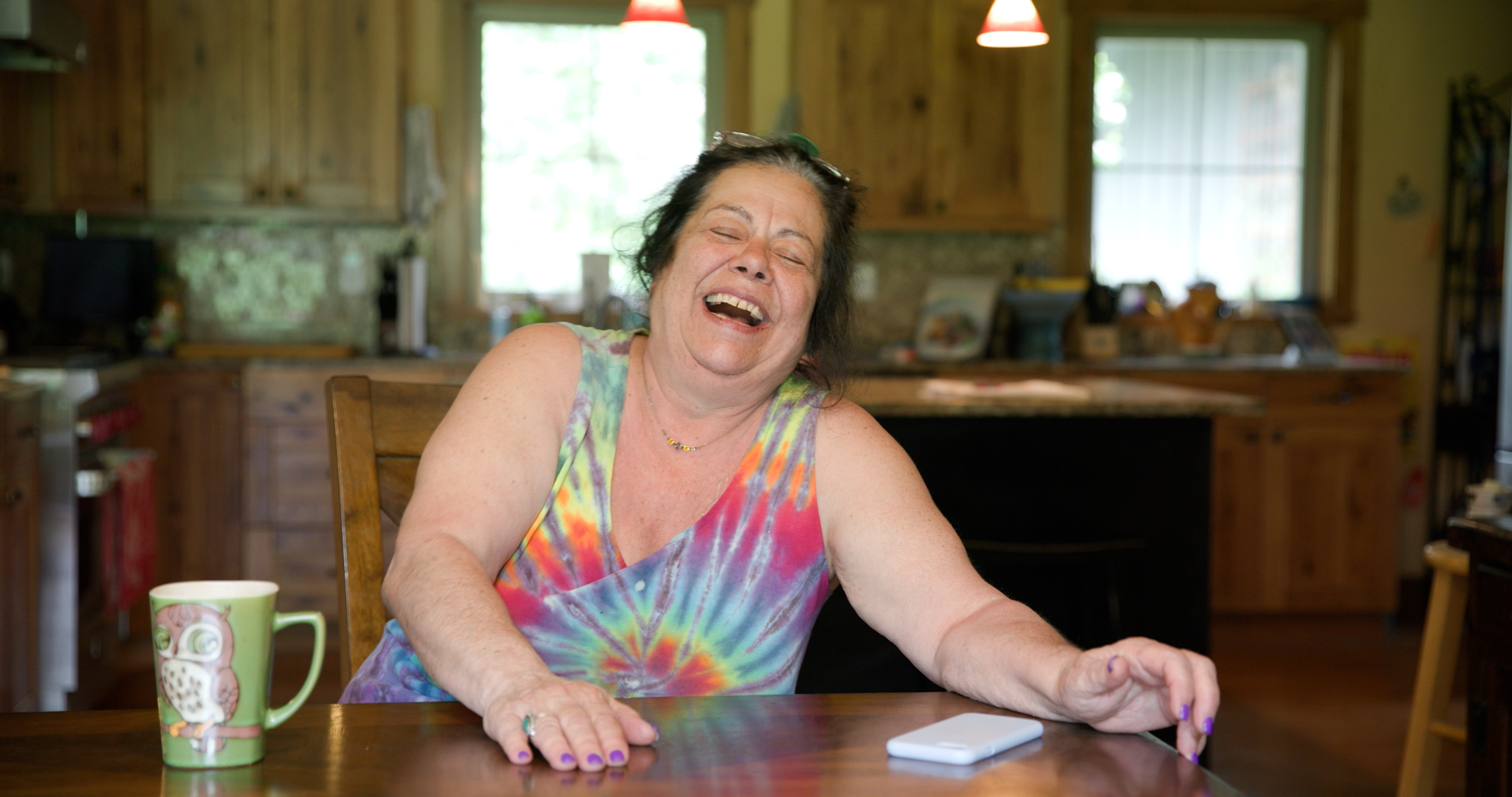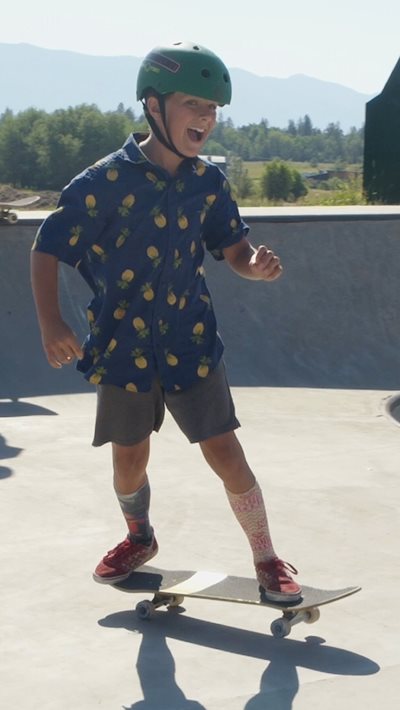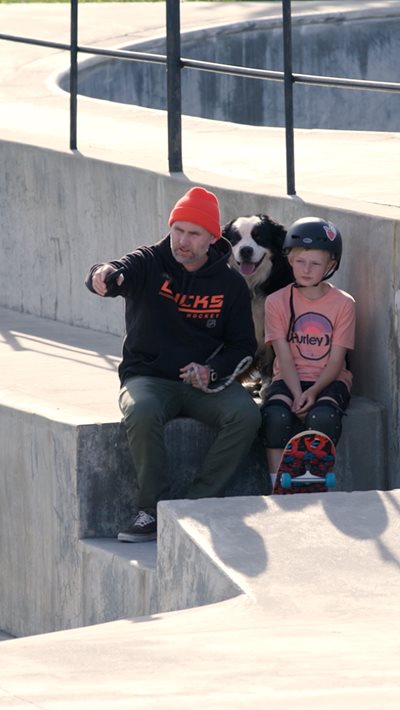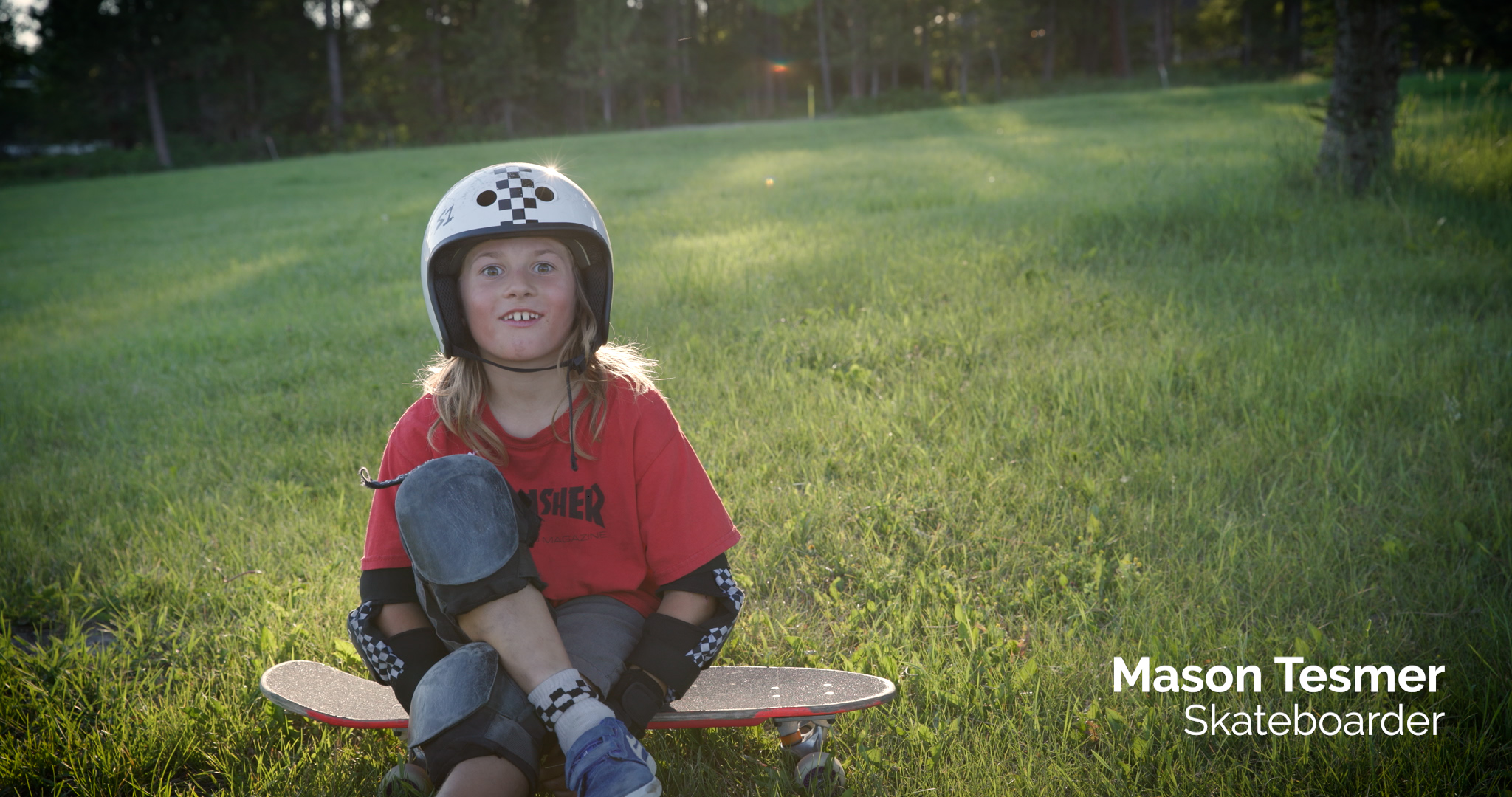A Clean Slate (and a Bigger Park) for Skateboarders…
“These parks are what I would lie in bed as a kid and dream of.”
If you’re a skateboarder of a certain age in Whitefish, Montana, chances are you know Pam Robinson.
Somewhat harried, the mom is known as the “Skateboarding Matriarch of Flathead Valley.” She would be hard to miss. Right now, she’s in a sleeveless tye-dyed shirt with purple nails. On her kitchen wall is a framed news article: “Mom leads push for skateboards.” Her phone rings. Naturally, it plays Simon and Garfunkel’s “Mrs. Robinson,” and she looks at it and laughs. “Oh God,” is all she says.
According to the Whitefish Skatepark Association, Pam Robinson is part of the reason Whitefish has a skatepark. And she did it for her kids.
“Well, the reason I pushed for the skateboard park is because my kids were way into it, and there was no place to go. And it was to keep my kids outta trouble, but it didn’t work real well because they still got in trouble,” she laughs, “but they had a smile on their face the whole time!”
She’s well-known in the skating community. And if you ask any of the members of the Whitefish Skatepark Association (WSA) — Leland McNamara, Matt Holloway, and Ryan Brown, or Spirit Skate Shop Owner Clay Taylor, or even local legend Kolby Zugg—if they know her, they’ll all nod.

“I think we all do a little bit, yeah,” laughs McNamara while the others chuckle in agreement. “When her kids were growing up and didn’t have a place to skate, and she knew all of the older generation was just gettin’ in trouble…she got some people together.”
Decades ago, skateboarding—and skateboarders—were considered “trouble.” With nowhere to skate, most kids would frequent public locations, private properties, and especially empty pools to practice their tricks, socialize, and have fun. They were seen as a public nuisance, and skating became a subculture often associated with misbehavior and recklessness. But all that’s changed.
“We needed skateparks here, and skateparks are important,” recalls McNamara. “And one started, then another, and another, and then another…and now Montana’s this kinda like skateboard park mecca.”
 “When Skate Park Association International was founded in 1996, the profile of the average skater was 12 to 14 years old, male and a street skater,” writes Heidi Lemmon in Skate Parks Benefit All. “There was only one public skate park at the time that featured obstacles as tall as 18 inches (all others had a lower height restriction), and as a result, kids were riding in the streets, illegally in most cities.” Now, she says, the average profile of a skater has changed dramatically. “It includes people ages 2 to 60 and older; males and females; individuals with disabilities; skateboarders, bicycle motocrossers (BMXers), scooterers, wheelchair users, and inline and roller skaters.”
“When Skate Park Association International was founded in 1996, the profile of the average skater was 12 to 14 years old, male and a street skater,” writes Heidi Lemmon in Skate Parks Benefit All. “There was only one public skate park at the time that featured obstacles as tall as 18 inches (all others had a lower height restriction), and as a result, kids were riding in the streets, illegally in most cities.” Now, she says, the average profile of a skater has changed dramatically. “It includes people ages 2 to 60 and older; males and females; individuals with disabilities; skateboarders, bicycle motocrossers (BMXers), scooterers, wheelchair users, and inline and roller skaters.”
With the sport now being included in Olympic events, what was once a subculture filled with kids skating in illegal and forbidden places has evolved into a sport of its own, and public interest has soared. And with more skateparks opening and flourishing every year, skaters not only have a place to go, but many of them now have a choice about where to skate.
Lemmon points out that well-designed parks attracted skaters, their families, and even events. The skaters themselves range from kids to young athletes and even older skaters. Afterschool programs, summer camps, and competitions can all create a chance to bring the community together and even encourage more people to hop on a skateboard.
“We needed skateparks here, and skateparks are important,” recalls McNamara. “And one started, then another, and another, and then another…and now Montana’s this kinda like skateboard park mecca.”
And it’s not just in Montana. Cities and towns across America see the benefits of including a skatepark in their parks and recreational programs. There are huge benefits. Along with the obvious physical activity, there’s the confidence that comes with challenges and skill building, but also the social nature of the activity that encourages friendships, support, and community spirit. Like other sports, skateboarding offers much more than just hopping on the board.
“It’s just a sport where you feel forever young,” says one of the WSA members.
“Yunno, whether you’re young or old, we’re all trying to do the same thing. Be that eternal teenager.”- McNamara
 McNamara agrees. “Yunno, whether you’re young or old, we’re all trying to do the same thing. Be that eternal teenager.”
McNamara agrees. “Yunno, whether you’re young or old, we’re all trying to do the same thing. Be that eternal teenager.”
And at the Whitefish skatepark—the Dave Olseth Memorial Skatepark—that’s exactly what’s happening. Skaters of all stripes, from beginner to pro, have journeyed to the park to have a go at its challenges.
It’s a park in the truest sense of the world. In some towns and cities, skateboard parks are kind of plunked down on the edges of green spaces, sometimes looking out of place, even a little rough, graffiti’d, and cramped. Not so for Whitefish Skatepark. The pristine, gentle slopes of concrete look—for a moment and from a distance—like something of a modern art installation in a park with notably lush, manicured green grass, surrounded by trees and park benches, set against the deep green canopy of a forest in the distance reaching towards the distant mountains. A blue sky stretches overhead, seemingly wider and greater than anywhere else in the world. A tacked-on afterthought? Not this park, ma’am.
And after 17 years of near-pristine skating, the WSA has ambitious plans to expand it, adding a “street plaza” with extensions, rails, stairs, ledges, and more.
“The expansion of the skatepark is huge,” says [Dreamland Skatepark Crew v/o?]. “When we designed it, I didn’t know what they were into. But now it’s been twenty years or so, fifteen years. Things have changed a little as far as style. I just call ‘em ‘flippy things’ and ‘jumpy things,’ ok?”
It’s designed to attract more seasoned skaters and create an area that would benefit beginners, especially drawing in newcomers to the park.
“I think having something a little smoother and easier would invite a little more kids to start skating,” says skate camp teacher Eric Kanter.
Back in the skate shop, Ryan Brown agrees. “The more ‘approachable’—as we would call it in the wine world—is, yunno, better,” he says and looks to Matt Holloway with a grin. “This is a really approachable cabernet.” They all laugh.
Ensuring the space is accessible and inviting to kids and newbies is important. Not only to give kids a fun outlet for exercise but because skating does foster those additional challenges to tackle obstacles and practice until you reach that state of ebullient achievement.
When asked why he likes skateboarding, Matt Tesmer—a kid with long sandy hair in a red Thrasher tee, with Vans-esque checkerboard protector pads and a round, vintage style helmet—pauses before announcing, “How hard it is” and grinning widely. Moments later, he’s soaring through the air, spinning his board, attempting the same tricks repeatedly, grunting through the hard landing until he finally sticks.
“Skateboarding, like you said, is really hard, and it takes a lot of work to get out of it, but then you do see results,” says Kanter. “So it’s like a way of seeing your hard work pay off. When kids see you trying new stuff, they wanna push past you. It’s kinda like this feed. You feed off each other. And I dunno, it brought something out in me that had been laying dormant for a while.”

In Whitefish, skating brings not just the community together but creates opportunities to invite people into the community. Like other more traditional sports, it’s fostering that sense of belonging, a mutual love for a sport. And local businesses—like Whitefish Credit Union—are getting involved, too.
Pam Robinson wants you to remember that.
“You can go to the Whitefish Credit Union, and you can give them a cheque and say, ‘Yes, this is for the skateboard park in Whitefish, Montana...”- Robinson
“So if you’re out there and you’ve got a couple of dollars in your pocket, send them our way,” laughs Robinson. “You can go to the Whitefish Credit Union, and you can give them a cheque and say, ‘Yes, this is for the skateboard park in Whitefish, Montana,” they know right where it goes…it’s gonna be for your children and the next generation.”
Check out and discover ways to support the WSA’s expansion plans here.
For members like you.
Because what we do pays dividends.
